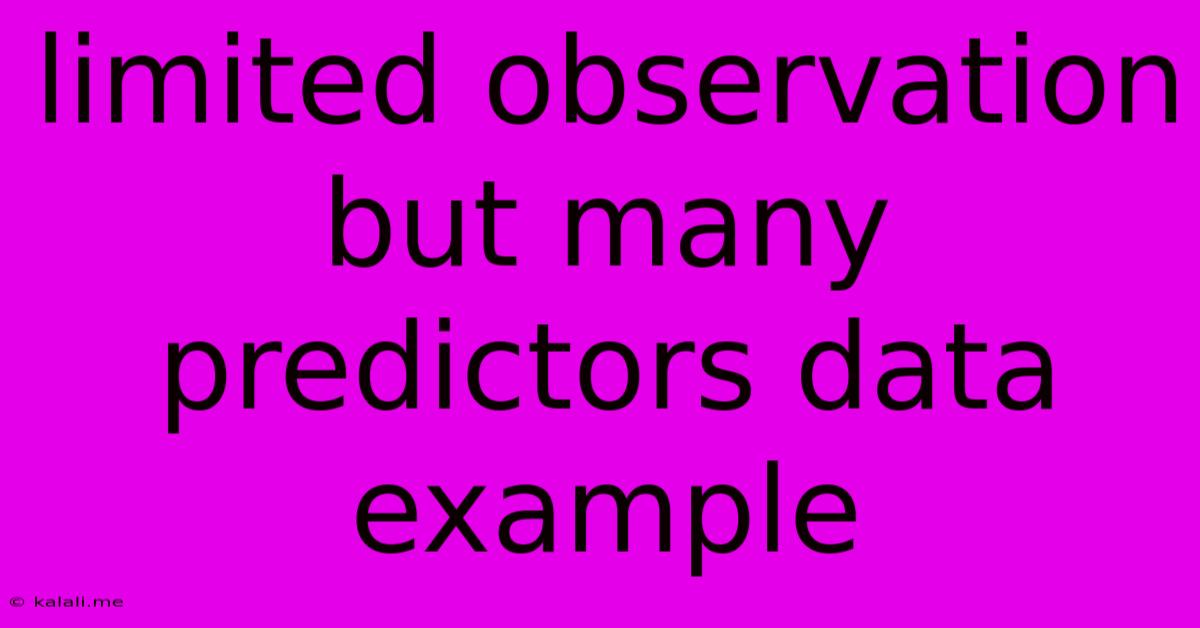Limited Observation But Many Predictors Data Example
Kalali
Jun 02, 2025 · 4 min read

Table of Contents
Limited Observation, Many Predictors: Navigating the High-Dimensional Data Challenge
Meta Description: This article explores the challenges of analyzing datasets with a limited number of observations but a large number of predictor variables. We'll discuss techniques like regularization, dimensionality reduction, and feature selection to overcome this "p >> n" problem.
The "p >> n" problem, where the number of predictors (p) significantly exceeds the number of observations (n), is a common hurdle in various fields, from genomics and finance to marketing and social sciences. This high-dimensionality presents significant challenges for traditional statistical methods, often leading to overfitting, unstable models, and poor predictive performance. This article will delve into this issue and explore effective strategies for tackling datasets with limited observations but many predictors.
Understanding the Problem
When you have far more predictors than observations, your model becomes incredibly susceptible to overfitting. Overfitting occurs when a model learns the noise in the training data rather than the underlying patterns, leading to excellent performance on the training set but poor generalization to new, unseen data. This renders the model practically useless for prediction or inference. Imagine trying to build a house with far too many individual bricks – the structure becomes unwieldy, unstable, and likely to collapse.
The core issue stems from the increased complexity of the model space. With many predictors, countless combinations of variables and interactions can be explored, greatly increasing the risk of finding spurious relationships that aren't truly representative of the underlying data generating process. This makes model selection and interpretation extremely difficult.
Strategies for Handling High-Dimensional Data with Limited Observations
Several techniques can mitigate the challenges of the "p >> n" problem:
1. Regularization: This approach modifies the model fitting process by adding a penalty term to the objective function. This penalty discourages overly complex models by shrinking the coefficients of less important predictors towards zero. Popular regularization techniques include:
- LASSO (Least Absolute Shrinkage and Selection Operator): This method performs variable selection by setting some coefficients to exactly zero, effectively eliminating irrelevant predictors from the model.
- Ridge Regression: This technique shrinks the coefficients towards zero but doesn't eliminate them entirely. It's particularly useful when many predictors have small, non-zero effects.
- Elastic Net: This combines LASSO and Ridge regression, offering a balance between variable selection and shrinkage.
2. Dimensionality Reduction: These methods aim to reduce the number of predictors by creating a smaller set of uncorrelated variables that capture most of the information in the original data. Common techniques include:
- Principal Component Analysis (PCA): This technique transforms the original variables into a new set of uncorrelated principal components, ordered by the amount of variance they explain.
- Linear Discriminant Analysis (LDA): This supervised technique aims to find linear combinations of predictors that best separate different classes or groups.
3. Feature Selection: This involves selecting a subset of the most relevant predictors for the model. Several techniques exist, including:
- Filter methods: These methods rank predictors based on their individual correlation with the outcome variable, selecting the top-ranked predictors.
- Wrapper methods: These methods iteratively select subsets of predictors, evaluating the performance of the model with each subset. Examples include forward selection and backward elimination.
- Embedded methods: These methods integrate feature selection into the model building process itself, as seen with LASSO regression.
Choosing the Right Approach
The best approach depends on the specific characteristics of your data and your research goals. Consider factors such as:
- The nature of your predictors: Are they continuous, categorical, or a mix?
- The size of your dataset: How many observations and predictors do you have?
- Your research goals: Are you aiming for prediction accuracy, variable interpretation, or both?
Experimentation with different techniques and careful evaluation using appropriate metrics are crucial for finding the most effective approach. Cross-validation is particularly important for assessing the generalization performance of your model, ensuring it performs well on new, unseen data.
Conclusion
Analyzing datasets with limited observations but many predictors is a significant challenge. However, by understanding the limitations of traditional methods and leveraging techniques like regularization, dimensionality reduction, and feature selection, researchers can build robust and reliable models, even in high-dimensional settings. The key is careful consideration of the data, the chosen method, and rigorous evaluation to ensure the model generalizes well and provides meaningful insights.
Latest Posts
Latest Posts
-
What Is Chaff In The Bible
Jun 04, 2025
-
Gas Fireplace Not Lighting But Pilot Is On
Jun 04, 2025
-
How To Fix A Towel Rack
Jun 04, 2025
-
Fallout 3 Where Is The Family
Jun 04, 2025
-
I Need A Job But Have No Transportation
Jun 04, 2025
Related Post
Thank you for visiting our website which covers about Limited Observation But Many Predictors Data Example . We hope the information provided has been useful to you. Feel free to contact us if you have any questions or need further assistance. See you next time and don't miss to bookmark.